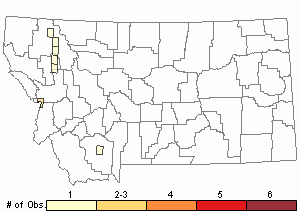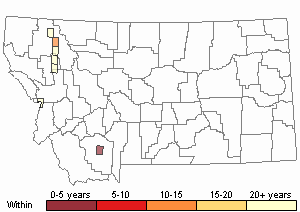View in other NatureServe Network Field Guides
NatureServe
Montana
Utah
Wyoming
Idaho
Wisconsin
British Columbia
South Carolina
Yukon
California
New York
Cat-tonque Liverwort - Conocephalum salebrosum
Other Names:
Snakeskin Liverwort,
Conocephalum conicum
General Description
Plants: Thallose, with thick, fleshy branches of dark green, large, particularly in damp areas, up to 25 cm in length and 6-22 mm across (Doyle 2006), lobe divisions uneven, with air chambers just below the dorsal surface showing hexagonal pattern, the one white-rimmed pore in the middle of each easily observed (Nicholson 1966, Schofield 2002).
Sex Organs: Archegoniophore stalks reaching up to 7 cm, found near ends of major branches. Female receptacles umbrella- or cone-shaped (hence the plant’s Latin name for “cone-shaped head”) with the archegonia on the bottom side (Bland 1971). Antheridia enclosed in purple-tinged protective pads near ends of lateral lobes (Doyle 2006, Schofield 1985, Nicholson 1966).
Diagnostic Characteristics
A crushed fresh thallus gives off an agreeable spicy odor (Bland 1971) or a smell like that of mushrooms (Doyle 2006). The archegonia-bearing receptacles with their cone-shaped umbrellas, the prominent air chamber outlines with white-bordered pores, and mushroom smell are unique (Schofield 2002, Doyle 2006).
Observations in Montana Natural Heritage Program Database
Number of Observations: 13
(Click on the following maps and charts to see full sized version)
Map Help and Descriptions
Relative Density

Recency



 (Observations spanning multiple months or years are excluded from time charts)
(Observations spanning multiple months or years are excluded from time charts)
Habitat
On moist soil and wet, shaded limestone and other rocks, in open-canopied woods, and on damp bluffs (Nicholson 1966, Schofield 2002).
Reproductive Characteristics
Archegoniophores noticeable in early spring. Antheridial pads show in late autumn and first part of spring. Sporangia with elators open longitudinally to discharge glossy black spores. Asexual reproduction may occur through fragmentation, when gemmae inside a decomposing thallus are eventually released (Schofield 2002).
Management
With insufficient light or inadequate conditions, branches become leaner and paler, often the case in efforts at cultivation (Nicholson 1966).
Stewardship Responsibility
References
- Literature Cited AboveLegend:
 View Online Publication
View Online Publication Bland, J.H. 1971. Forests of Lilliput: The Realm of Mosses and Lichens. Englewood Cliffs, NJ: Prentice-Hall. 210 p.
Bland, J.H. 1971. Forests of Lilliput: The Realm of Mosses and Lichens. Englewood Cliffs, NJ: Prentice-Hall. 210 p. Doyle, W.T. and R.E. Stotler. 2006. Contributions Toward a Bryoflora of California III. Keys and Annotated Species Catalogue for Liverworts and Hornworts. Madroño 53(2): 89-197.
Doyle, W.T. and R.E. Stotler. 2006. Contributions Toward a Bryoflora of California III. Keys and Annotated Species Catalogue for Liverworts and Hornworts. Madroño 53(2): 89-197. Nicholson, B.E. and F.H. Brightman. 1966. The Oxford Book of Flowerless Plants: Ferns, Fungi, Mosses and Liverworts, Lichens, and Seaweeds. London: Oxford University Press. 208 p.
Nicholson, B.E. and F.H. Brightman. 1966. The Oxford Book of Flowerless Plants: Ferns, Fungi, Mosses and Liverworts, Lichens, and Seaweeds. London: Oxford University Press. 208 p. Schofield, W.B. 1985. Introduction to Bryology. Caldwell, NJ: Blackburn Press. 434 p.
Schofield, W.B. 1985. Introduction to Bryology. Caldwell, NJ: Blackburn Press. 434 p. Schofield, W.B., P. Drukker-Brammall, and M. Pacheco. 2002. Field Guide to Liverwort Genera of Pacific North America. Banff, AB: Global Forest Society in association with University of Washington Press. 228 p.
Schofield, W.B., P. Drukker-Brammall, and M. Pacheco. 2002. Field Guide to Liverwort Genera of Pacific North America. Banff, AB: Global Forest Society in association with University of Washington Press. 228 p.
- Additional ReferencesLegend:
 View Online Publication
View Online Publication
Do you know of a citation we're missing? Elliot, J. C. 1993. Second checklist of Montana mosses. Unpublished report. U.S. Forest Service, Region 1. Missoula, MT. 45 pp.
Elliot, J. C. 1993. Second checklist of Montana mosses. Unpublished report. U.S. Forest Service, Region 1. Missoula, MT. 45 pp.
- Web Search Engines for Articles on "Cat-tonque Liverwort"





